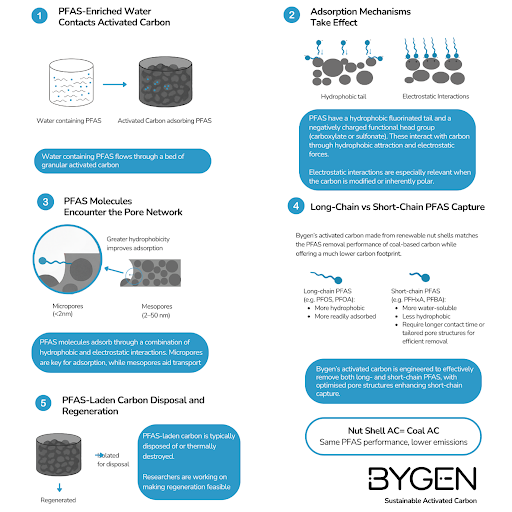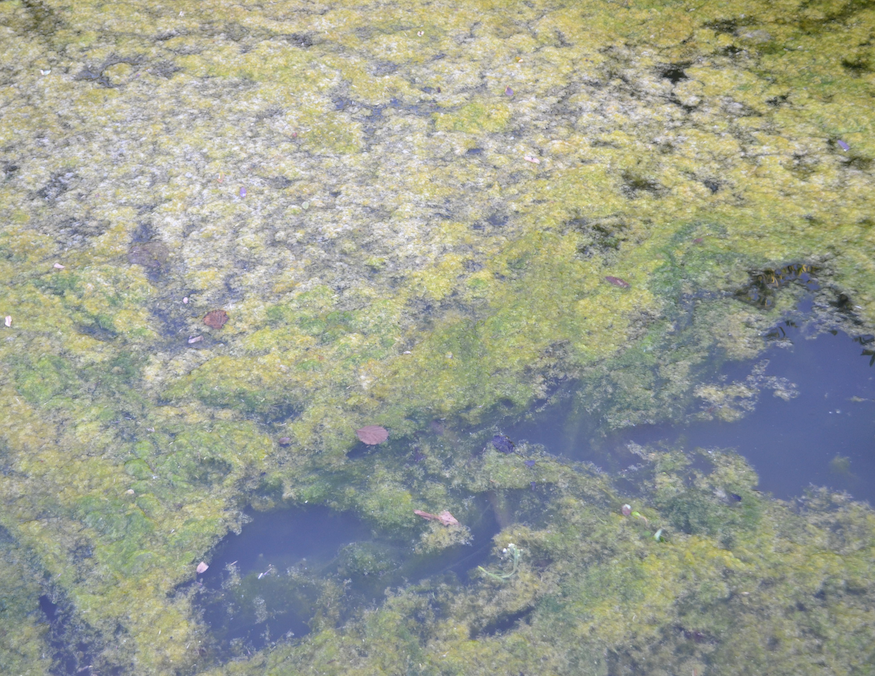Submission to the Senate Select Committee on PFAS - Bygen Pty Ltd
- Bygen
- Jul 31
- 6 min read
Executive Summary
Per- and polyfluoroalkyl substances (PFAS) are persistent environmental pollutants with known health and ecological risks, yet public awareness and policy implementation in Australia remain limited. While international markets are actively scaling PFAS treatment solutions, Australia lags behind. Bygen is an Australian-based manufacturer of sustainable, PFAS-specific activated carbon products, developed through years of research here in Australia. Our targeted products are produced using renewable feedstocks and proprietary low-temperature activation technology, delivering enhanced removal performance for both long- and short-chain PFAS compounds. We believe public funding is urgently needed to support pilot programs that validate and accelerate the deployment of such scalable, local solutions for the effective, low-cost removal of PFAS from contaminated water and soil. This submission outlines our observations, recommendations and technical experience to support more coordinated national PFAS management.
About Bygen
Bygen is an Australian advanced manufacturer of sustainable activated carbon for environmental applications, including PFAS remediation. We are a spin-out from the University of Adelaide and our production process uses agricultural by-products such as nut shells and wood. Our activated carbon is used in water treatment, soil remediation, and industrial filtration projects, in Australia and abroad.

Our PFAS-specific activated carbon is the result of years of targeted research. It features enhanced hydrophobicity and a carefully balanced combination of mesopores and micropores, significantly improving the adsorption of both long- and short-chain PFAS. According to Dr Mohammad S Islam, Bygen’s Head of Research, Development and Product, activated carbon removes PFAS primarily through hydrophobic and electrostatic interactions within its micro- and mesoporous structure.
Key applications include:
Drinking Water Treatment: Granulated Activated Carbon (GAC) is integrated into filtration systems at some Drinking Water Plants, helping achieve high PFAS removal efficiency with minimal waste generation.
Wastewater Treatment: Powdered Activated Carbon (PAC) provides rapid adsorption in Wastewater Treatment Plants (WWTPs), suitable for batch processes or integration into existing treatment systems.
Soil Remediation: PAC and GAC can be applied to immobilise PFAS in contaminated soils, reducing leachability without disrupting soil structure.
Bygen’s solution is a proven, high-performance, low-energy, and environmentally sustainable option. Despite Australia’s strong innovation capabilities, local adoption of our targeted products has lagged the uptake in international markets. We believe public funding for pilot programs is essential to allow Water Utilities to validate our cost-effective PFAS-removal solution, and accelerate remediation efforts wherever PFAS treatment is required.
This submission reflects our technical experience in PFAS remediation and our observations from working with regulators, Water Utilities and consultants. We welcome the opportunity to contribute and support improved national responses to PFAS risks.
1. Extent of Data Collection
Based on our experience in the field, PFAS contamination in Australia is more widespread than public datasets currently reflect. While several high-profile sites (e.g. defence bases, airports) have been mapped, many areas - particularly regional catchments, agricultural land, and industrial zones - have not been routinely tested.
We support a nationally coordinated PFAS sampling program, encompassing surface water, groundwater, soils, and biosolids. This would help identify risks early and prioritise interventions. As a remediation provider, we often find ourselves working reactively, because reliable baseline data is lacking.
2. Sources of Exposure
PFAS are entering the environment from legacy firefighting foams, industrial discharges, landfill leachate, and increasingly from wastewater streams containing domestic and commercial PFAS-containing products. These ‘forever chemicals’ accumulate in biosolids, groundwater, and river systems.
We emphasise the role of wastewater and solid waste streams as under-recognised ongoing exposure pathways. Many WWTPs and landfills were not designed with PFAS in mind and have no dedicated removal or capture systems in place.
3. Impacts on Health, Environment, and Society
PFAS are persistent, mobile, and bioaccumulative. Exposure has been linked to cholesterol elevation, immune suppression, and developmental effects. Our concern is not only for health risks, but also the broader environmental and social toll: wildlife exposure, contamination of agricultural products, and community distress.
We also note the disproportionate impact on regional communities and some First Nations groups. These communities often lack the resources to test, monitor, or remediate PFAS - despite living closest to affected environments.

4. Challenges in Research and Coordination
Although Australian institutions have conducted research into PFAS and its possible elimination in the Australian context, opportunities remain to improve coordination and sustained public funding for PFAS-related research. Much of the technical guidance still relies on international studies, underscoring the value of expanding site-specific, locally generated data to support decision-making.
We recommend dedicated funding for PFAS treatment pilots, particularly for emerging technologies and smaller-scale local solutions that are effective and relatively cheaper than other solutions on the market. This would accelerate safe deployment and provide decision-makers with better evidence.
5. Effectiveness of Regulatory Frameworks
Australia’s regulatory system for PFAS remains fragmented. While the National Environmental Management Plan (NEMP) provides guidance, enforcement and implementation vary between jurisdictions.
In our view, key gaps include:
Absence of enforceable national limits for PFAS in drinking water and discharge.
financial backing.
A lack of interim standards for newer PFAS compounds beyond PFOS, PFOA and PFHxS.
Recent moves to revise the Australian Drinking Water Guidelines are welcome. However, to be effective, revised limits must be accompanied by resources and timeframes to help Australian Water Utilities comply.
6. Responsibility of Government and Industry
PFAS contamination has arisen from both government activities (e.g. firefighting foam use at defence and aviation sites) and industrial product supply chains.
We support the principle that responsible parties, where identifiable, should fund remediation. However, where pollution sources are diffuse or historical, the government should step in to protect communities and fund clean-up.
We also recommend:
Mandatory PFAS product reporting and tracking.
Clear accountability pathways for site custodians, including for disposal and containment of PFAS-impacted materials.
7. International Best Practices in Management and Disposal
Australia lags behind countries like the U.S. and Sweden in PFAS destruction capability. We currently lack a proven, commercial-scale domestic method to destroy PFAS in spent carbon, resins, or contaminated soil.
We urge investment in domestic PFAS destruction infrastructure - such as thermal treatment, supercritical water oxidation, or electrochemical methods. In the interim, guidelines should ensure safe containment and transparent tracking of PFAS wastes to long-term storage sites.
8. Community Engagement and Support
Affected communities need timely, clear communication, and appropriate support. The delay in community notification at various sites in recent years has eroded trust.
We recommend:
Clear, consistent PFAS communication protocols across all jurisdictions.
Health monitoring and mental health support in highly impacted areas.
Compensation and relocation options where PFAS contamination is extensive and long-term.
9. Effectiveness of Remediation Works
Activated carbon is widely used for PFAS capture from water and is supported by extensive field data. It is one of the few scalable, commercially available solutions that can immediately reduce exposure from drinking water, wastewater, and contaminated soil.
Australia has a strong opportunity to trial and scale local innovations like Bygen’s GAC and PAC, rather than relying on imported or Australian coal-based carbon.
10. International Best Practice in Risk Assessment
Internationally, leading practice includes extremely low PFAS thresholds (e.g. 4 parts per trillion in drinking water in the U.S.), and regulation by chemical class rather than by individual compound.
Dr Islam has emphasised that performance-based standards across PFAS chain lengths are essential, particularly as shorter-chain compounds present different technical challenges. Class-based regulation would better reflect how treatment systems and environmental pathways behave.
11. Areas for Reform
We recommend the following:
Allocate public funding for field-scale pilot programs to validate Bygen’s activated carbon solutions and demonstrate performance.
Enhance public awareness campaigns to educate communities on PFAS risks and build trust in remediation.
Update and strengthen the PFAS NEMP to incorporate findings from pilot programs and align with international standards.
Foster industry collaboration between innovators like Bygen, government agencies, and utilities to accelerate PFAS remediation.
Promote procurement policies that prioritise sustainable, Australian-made PFAS solutions.
Develop an independent national PFAS advisory panel to guide research, technology adoption, and future regulation.
Conclusion
PFAS contamination is a growing concern that demands immediate, scalable solutions. Bygen’s sustainable, PFAS-specific activated carbon, produced from renewable feedstocks offers a proven approach to remediate PFAS in drinking water, wastewater, and soils.
As an Australian start-up with a rapidly expanding global presence, we are uniquely positioned to address this challenge locally while aligning with global standards. However, the slow adoption of our solutions in Australia highlights the need for public funding to support pilot programs.
These initiatives will validate our technology, reduce costs, and increase public awareness and trust, supporting the goals of the PFAS NEMP and international best practices. We urge the Select Committee to prioritise funding and coordination to advance sustainable PFAS remediation.
Contact Information
Bygen Pty Ltd
Email: info@bygen.com.au
Website: www.bygen.com.au
Appendix A:
Technical Perspective - Activated Carbon in PFAS Remediation
Prepared by Dr Mohammad S Islam, Head of Research, Development and Product, Bygen Pty Ltd
Reference:
Department of Climate Change, Energy, the Environment and Water (DCCEEW). (2025). PFAS National Environmental Management Plan (NEMP) Version 3.0.
Nguyen, H.T., et al. (2024). Nationwide occurrence and discharge mass load of per- and polyfluoroalkyl substances in effluent and biosolids: A snapshot from 75 wastewater treatment plants across Australia. Journal of Hazardous Materials.
U.S. Environmental Protection Agency (EPA). (2023). National Primary Drinking Water Regulation for PFAS – Final Rule.
Ross, I., et al. (2018). A review of emerging technologies for remediation of PFASs. Remediation Journal, 28(2), 101–126.


